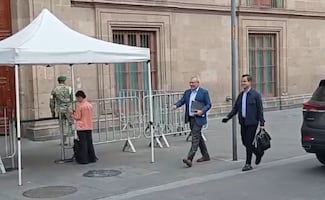Más Información

Senador del PT propone crear televisión, radio y periódico de la 4T; debemos hacer frente a medios de derecha, dice

César Duarte comparece ante jueza en penal del Altiplano; buscan vincularlo por presunto lavado de dinero

¿Qué es el Tratado de Aguas de 1944 entre México y EU por el que Trump amaga con imponer aranceles?; te explicamos

Gobernador de Michoacán se reúne con Sheinbaum en Palacio Nacional; acude también gabinete de Seguridad

Posponen en el Senado discusión y votación de reforma para crear la figura de “jueces sin rostro”; se discutirá en febrero

VIDEO Hallan a pareja sin vida en colonia Lindavista; una de las víctimas era abogado que litigó temas de despojos en Ecatepec
Next to Periférico, in the Benito Juárez borough, the National Institute of Anthropology and History (INAH) reopened the Archeological Zone of Mixcoac after being closed 77 years to safeguard and prevent the looting of historical vestiges .
Authorities made a tour in which the observed the elements that conform this site: a pyramid in honor of the god Mixcóatl , a ceremonial square , a central patio , and the new museum that works as an introduction so that, through photographs and illustrations , the visitors get to know more about the history of the compound.
“There used to be only some scheduled visits; although this zone has been explored for 100 years , it did not have the conditions to receive the public. Now, with an effort from different agencies, the Culture Ministry , and the decision of Diego Prieto (director of INAH) it has been reopened,” said Pedro Francisco Sánchez , national coordinator of archeology of INAH.
He added that among the changes, there are two security cabins , a parking lot , the paths and ramps for the disabled were refurbished , and they put signaling , as well as sanitary services.
Those who inhabited the area of San Pedro de Los Pinos more than 100 years ago, thought that it was a kind of natural elevation . Then, they noticed it was artificial and it was in 1916 when historian Francisco Fernández Castillo made the first description of the vestiges, explained Pedro Francisco Sánchez.
Nowadays, only the small part of the pre-Hispanic settlement is preserved, which corresponds to its last stage . Francisco Sánchez said that this is the last space open to the public in Mexico City, nevertheless, he hopes that with the works of expansion of the subway new archeological zones are found.
Roberto Gallegos Ruiz
, who has been five years in charge of the restoration of this space shared some of the historical information of the place; he explained the origin of the only pre-Hispanic god that knows how to use weapons, Mixcóatl .
They discovered the site in 1916 in the Uppsala Map , used in the times of the Conquest by the Spanish to locate destroyed and new places.
The Archeological Zone of Mixcoac is the fifth site in Mexico City along with the Templo Mayor, Tlatelolco, Cerro de la Estrella, and Cuicuilco .
It is one of the smallest archeological sites in Mexico with 7,200 square meters . Diego Prieto added that this site “is like a flower amidst the asphalt , for it is, practically, embedded next to Periférico, surrounded by housing units and roads.”
Mixcoac
, which means “ where the clouds snake is worshiped ” in náhuatl, dates from the times of Teotihuacán , but the vestiges that can be visited are from the Mexica occupation.
During the opening ceremony last August 24th , the mayor of this borough, Santiago Taboada , gave a recognition to Roberto Gallegos for his long career in the field of Archeology. For its part, the INAH also gave a recognition to the restaurateur with an award with the figure of a silver eagle.
The access will be free and it will be open from 9:00 to 17:00 every day.
mp
Noticias según tus intereses
[Publicidad]
[Publicidad]











